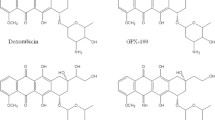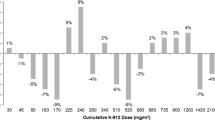Abstract
Coupling of anthracyclines to high-molecular-weight carriers may alter drug disposition and improve antitumor effects. We have performed a clinical phase I trial of doxorubicin coupled to dextran (70000 m.w.). The drug was administered as single dose i.v. every 21–28 days. Thirteen patients have received a total of 24 courses (median 2; range 1–3). At the starting dose of 40 mg/m2 doxorubicin equivalent (DOXeq), WHO grade IV thrombocytopenia was noted in 2/2 patients. WHO grade IV hepatotoxicity and WHO grade III cardiotoxicity were noted in a patient with preexisting heart disease. Five patients were treated with 12.5 mg/m2 DOXeq. Maximal toxicity at this dose level was WHO grade III thrombocytopenia and local phlebitis (WHO grade II) in 1/5 patients, elevation of alkaline phosphatase (WHO grade III) and WHO grade III vomiting in another patient. Subsequently, five patients received 20 mg/m2 DOXeq. Hepatotoxicity was noted in 5/5 patients (1 × WHO grade IV, 1 × WHO grade III). Thrombocytopenia was noted in 3/5 patients (1 × WHO grade IV, 2 × WHO grade III). At 12.5 mg/m2 DOXeq, a patient diagnosed with a malignant fibrous histiocytoma had stable disease for 4 months. Pharmacokinetic analyses of total and free doxorubicin were performed in plasma and urine. The maximum peak plasma concentration (ppc) for total DOX was 12.3 μg/ml at 40 mg/m2 DOXeq. The area under the plasma concentration time curve (AUC) ranged from 28.83–80.21 μg/ml*h with dose-dependent elimination half lives (t1/2α: 0.02–0.87 h;1/2β: 2.69–11.58 h;1/2γ: 41.44–136.58 h). We conclude that the maximal tolerated dose (MTD) of AD-70 using this schedule is 40 mg/m2 DOXeq. The recommended dose for clinical phase II studies is 12.5 mg/m2 DOXeq.
Similar content being viewed by others
Abbreviations
- ALT:
-
Alanine Aminotransferase
- AST:
-
Aspartate Aminotransferase
- DOX:
-
Doxorubicin
- DOXeq:
-
Doxorubicin Equivalent
- ECG:
-
Electrocardiogram
- HPLC:
-
High Pressure Liquid Chromatography
- LD10 :
-
Lethal Dose for 10% of individuals
- MTD:
-
Maximal Tolerated Dose
- ppc:
-
Peak Plasma Concentration
- WHO:
-
World Health Organisation
References
Myers CE, Chabner BA: Anthracyclines. In: B.A. Chabner and J.M. Collins (eds.), Cancer Chemotherapy: Principles and Practice, pp. 356–381. J.B. Lippincott Company, Philadelphia, 1990
Henderson IC, Frei III E: Adriamycin and the heart. New Engl J Med 300:310–312, 1979
Duncan R: Drug-polymer conjugates: potential for improved chemotherapy. Anti-Cancer Drugs 3:175–210, 1992
Bernstein A, Hurwitz E, Marnon R, Arnon R, Sela M, Wilchek M: Higher antitumor efficacy of daunomycin when linked to dextran: in vivo and in vitro studies. J Natl Cancer Inst 60:379–384, 1978
Levi-Schaffer F, Bernstein A, Meshorer A, Arnon R: Reduced toxicity of daunorubicin by conjugation to dextran. Cancer Treat Rep 66:107–112, 1982
Ueda Y, Kikukawa A, Munechika K, Yamanouchi K, Yokoyama K: Comparative distribution of adriamycin linked to oxidized dextran and free adriamycin in tumorbearing animals. Proc Intern Symp Control Rel Bioact Mater 16:142–143, 1989
Ueda Y, Munechika K, Kikukawa A, Kanoh Y, Yamanouchi K, Yokoyama K: Comparison of efficacy, toxicity and pharmacokinetics of free adriamycin and adriamycin linked to oxidized dextran in rats. Chem Pharm Bull 37:1639–1641, 1989
Kikukawa A, Munechika K, Ueda Y, Yamanouchi K, Yokoyama K, Tsukagoshi S: Tissue concentration of adriamycin and adriamycin-oxidized dextran conjugate in tumor bearing rats and mice. Drug Delivery Syst 5:255–260, 1990
Yamaoka K, Tanigawara Y, Kakagawa T, Uno T: A pharmacokinetic analysis program (MULTI) for microcomputer. J Pharm Dyn 4:879–885, 1981
Yamaoka K, Nakagawa T: A nonlinear least squares program based on differential equations, MULTI (RUNGE), for microcomputers. J Pharm Dyn 6:595–606, 1983
Sogame Y, Munechika K, Kawabata Y, Ueda Y, Tsuda Y, Yokoyama K, Tsukagoshi S: Distribution of adriamycinoxidized dextran conjugate (ADM-OXD) in tumor-bearing rats. Drug Delivery Syst 7:181–185, 1992
Yokoyama K, Ueda Y, Kikukawa A, Yamanouchi K: Drug Delivery Systems: The Industrial View. In: G. Gregoriadis (ed.), Targeting of Drugs, pp. 137–153. Plenum Press, New York, 1990
Munechika K, Nakae T, Kikukawa A, Ueda Y, Yamanouchi K, Yokoyama K, Tsukagoshi S: Intracellular behavior of adriamycin-oxidized dextran conjugate. Drug Delivery Syst 6:127–131, 1991
Iwai K, Meada H, Konno T: Use of oily contrast medium for selective drug targeting to tumor: enhanced therapeutic effect and x-ray image. Cancer Res 44:2115–2121, 1984
Fujita H, Okamoto M, Takao A: Pharmacokinetics of adriamycin-oxidized dextran conjugate (ADM-OXD) in experimental animals. Drug Delivery Syst 6:133–138, 1991
Author information
Authors and Affiliations
Rights and permissions
About this article
Cite this article
Danhauser-Riedl, S., Hausmann, E., Schick, HD. et al. Phase I clinical and pharmacokinetic trial of dextran conjugated doxorubicin (AD-70, DOX-OXD). Invest New Drugs 11, 187–195 (1993). https://doi.org/10.1007/BF00874153
Issue Date:
DOI: https://doi.org/10.1007/BF00874153




